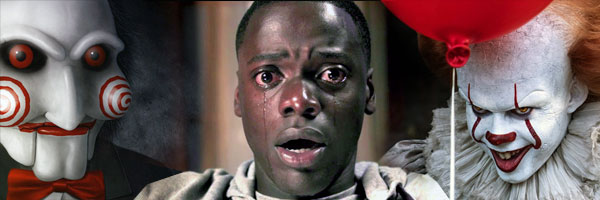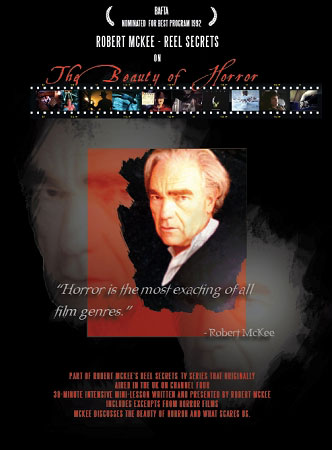The Pleasures of Horror

The recent wave of successful of Horror films speaks to a society suffering tremulous feelings of vulnerability, constant fear and dread, helplessness, paralysis, frustration, and rage.
Like all genres, Horror goes in and out of fashion. Right now it’s very in. And like all genres, Horror rewrites its conventions in reaction to the changing attitudes and values of society.
During the 1930’s, the era of the Great Depression and the rise of Nazism, horror offered us traditional monsters of the supernatural (DRACULA), the uncanny (KING KONG), and the manmade (FRANKENSTEIN).
In the Nuclear Age and Cold War of the 1950’s, Horror brought us radioactive mutations (THEM) and social paranoia (INVASION OF THE BODY SNATCHERS).
Ours, however, is an age of compound nightmares:
a. Nuclear Outlaw Nations.
b. Economic Disasters.
c. Natural Disasters.
d. Man-made Disasters.
e. Plagues of Viruses.
f. Rampant Crime.
g. Serial Killers.
h. Toxic Environments.
i. Global Warming.
j. Rising Seas.
k. Opiate Epidemics.
l. Gender Wars.
m. Sexual Assaults.
n. Lunatic Politicians.
o. International Terrorism.
p. National Terrorism of mass shootings from Sandy Hook to Virginia Tech to Orlando to Las Vegas.
The aim of modern Horror is to expiate these emotions with a vicarious experience of damnation, of the fate worse than death. To do so, it uses both horror and terror. To horrify means to cause extreme repulsion; to terrify, to cause extreme fear. Or in the words of a renowned horror producer, “Not a dry seat in the house.”
Why do people want this experience? For at least a half dozen reasons I can think of.
One: Horror serves as a training film for survival.
Many films, from ALIEN (1979) to SAW (2004) to HOSTEL (2005) to LIFE (2017), offer up an allegory of humanity in the form of group confined to an isolated dwelling, and then sort through various victim traits looking for the survivor—someone like Sigourney Weaver’s Ellen Ripley who has a balanced combination of courage, discretion, cool, and brains.
Two: Horror releases our repressions.
We all have antisocial and self-destructive impulses we must repress. We struggle to control our impulses, because if not, they lead to perversity, violence, and death. Great pleasure comes from suffering them vicariously in the safe environment of a movie house. As David Cronenburg put it, “People must confront their hidden natures. It’s healthy. But in the cinema, metaphorically, not in life, actually.”
Three: Horror releases pent up fear.
Not the mere fear of death. If it were simply that, Horror wouldn’t work. Going out of existence isn’t that bad. The greatest fear is the fear of the fate worse than death, the living death known as damnation. In Crime stories, a victim begs for his life; in Horror, he begs for his death. In Horror, suffering is so unbearable going out of existence is a mercy.
Four: Horror releases us from social suffocation.
Modern life deadens us. The repetitiousness of our days numbs our capacity to feel strong emotions. Horror spurs these emotions to life. The traditional storified emotions of fear, suspense, and surprise in Horror become terror, anxiety, and shock.
Five: Mary Shelly said, “Frankenstein was my attempt to speak to the mysterious fears and desires hidden deep within our natures.”
Horror wires us up to our subconscious, and when it makes that connection, we experience a rush of identification with great power, or what is commonly called sadomasochism.
Sadism is the pleasure that comes with a feeling of power over life and death. Admit it or not, at times we all suffer feelings of helplessness and vulnerability. These feelings are dispelled when we identify with a monster and feel the thrill of aggression, of pure, limitless, sadistic power.
Masochism is the pleasure of sheltering in the shadow of great power. Feelings of helplessness can be overcome by cowering in the aura of a powerful person who must, ironically, constantly demonstrate his power or we lose trust. How? By hurting us. The Horror audience is induced to identify with the victim, as we too may become a victim in life if we grant someone the “right” to humiliate us.
Truth be told, a little sadomasochist hides in us all and comes out when we’re feeling powerless in the face of forces that threaten our existence, literally or figuratively. In the safe environment of Horror a deep pleasure alternates between repulsion from and attraction to power, between terror and rage, between dread and desire.
Six: Horror is healthy fun.
Concentrating only on the grotesquery of Horror films misses the inner reasons people flock to this genre. Horror provides the aesthetic experience of buried emotions.
In Stanley Kubrick’s words, “Monsters and mad men are simply extensions or exaggerations of deep strains present in us all. If people don’t want the horror experience once in a while, I think there’s a side of themselves they’re not facing.”
Joan Kaminsky, who writes horror under the pen name of Brooks Stanwood, said, “Horror allows us to think the unthinkable and actually enjoy it. It’s like directing your nightmares.”
Beyond the catharsis of fear overloads and repressed desires, Horror is an emotional roller-coaster ride. Bouncing back and forth between revulsion and thrills is a kick.
Originally aired in the U.K., this is Robert McKee’s half-hour program on the beauty of horror and what scares us.
Exclusive to the McKee Store.
